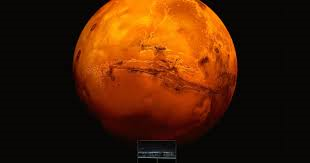Scientists have spotted a 12 mile-wide stretch of water underneath a slab of ice at the Martian south pole
Astronomers have found compelling evidence that there is a huge reservoir of liquid water buried a mile under the ice near the south pole on Mars.
Radar measurements taken from the European Space Agency’s Mars Express orbiter spotted the 12 mile-wide stretch of water at the base of a thick slab of polar ice in a region known as Planum Australe.
It is the first time that researchers have identified a stable body of liquid water on the red planet. The finding raises the likelihood that any microbial life that arose on Mars may continue to eke out a rather bleak existence deep beneath the surface.
“We discovered water on Mars,” said Roberto Orosei at the National Institute of Astrophysics in Bologna. Any other explanation for the bright reflections the scientists saw in their radar observations was “untenable”, he added. Details of the finding are reported in the journal, Science.
Today, the most obvious signs that Mars was once a wet world are the ancient waterways that sculpted the planet’s surface many millions of years ago. In 2015, Nasa announced that it had spotted water seeping down slopes and gullies on the planet, but that interpretation was cast into doubt last year when US Geological Survey researchers argued that the mysterious dark streaks were no more than tumbling grains.
For the latest discovery, researchers in Italy analysed three years of data gathered by an instrument called the Mars Advanced Radar for Subsurface and Ionosphere Sounding, or Marsis, onboard the Mars Express probe. The measurements, collected between 2012 and 2015, show that radar waves penetrated the clear ice at the Martian south pole but reflected strongly off a body of water that lay beneath.
John Bridges, a professor of planetary science at the University of Leicester, who helped locate the final resting place of the UK’s Beagle 2 lander on Mars, said the scientists had made a convincing case for liquid water on Mars. “It’s a careful analysis of the data. There’s certainly a good basis for it,” he said.
Elena Pettinelli, a scientist on the team at Roma Tre University, said it was impossible to know whether the body of water was a lake or an aquifer where the water filled interconnected pores in Martian rock. If it is an open body of water, it may resemble Lake Vostok, the largest subglacial lake in Antarctica, she said.
Nor can the scientists tell how deep the water is. The radar pulses from the Marsis instrument bounce back off the water but don’t reach the bottom of the reservoir. The best the scientists can say is that the water is at least a metre or two deep.
What they do know is that the water is extremely cold. At the bottom of the ice at the Martian south pole, the temperature is estimated to be about -68C. Though far below zero, the water is thought to remain liquid because it is under pressure and rich in salts, in particular magnesium, calcium, and sodium compounds known as perchlorates, which are readily found on the surface of Mars.
While hardly ideal for life as we know it, the briny fluid could potentially support microbes which have adapted to such salty conditions. The challenge any Martian microbes would face is resisting the osmotic potential which acts to draw water out of cells and leave them in a desiccated heap. “This is certainly not a very pleasant environment for life,” said Orosei. Though not an expert in the harsh extremes that life can endure, Bridges suspects the salty conditions in the Martian water might be too much to survive. “I think it’s really, really stretching the envelope of potential life to bursting point,” he said.
Mark Sephton, who researches life in extreme environments at Imperial College, London, said that the water being so far under the surface of Mars was not in itself a problem for life. The surface of Mars is bombarded by intense radiation that effectively sterilises the surface, so if life lurks anywhere on the planet, it is likely to be underground. “As long as there is an energy source to exploit and a source of nutrients or raw materials then life is possible,” he said.
“High salt conditions are good for maintaining a liquid state but are a challenge for life. If the salt concentrations outside of the cell are higher than the inside then it draws water out from inside the cell and the cell shrinks and desiccates. Life can adapt by synthesising organic molecules to stop the process but there are limits, beyond which the high salinities in the cell interfere with biochemistry and the cell dies,” Sephton added. “So for Mars, some mechanisms which keep water in a liquid state can operate at levels that are too much of a good thing for life.”
It may be some time before scientists can investigate the water under the Martian south pole to see if any life lurks there. “Getting there and acquiring the final evidence that this is indeed a lake will not be an easy task,” said Orosei. “It will require flying a robot there which is capable of drilling through 1.5km of ice and this will certainly require some technological developments that at the moment are not available.”
For now, the researchers will search other sites on Mars for signs of more subterranean lakes or aquifers. Writing in the journal, the authors say: “There is no reason to conclude that the presence of subsurface water on Mars is limited to a single location.”
The Guardian
 Lebanese Ministry of Information
Lebanese Ministry of Information



